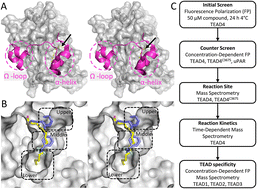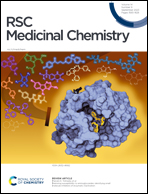Chloroacetamide fragment library screening identifies new scaffolds for covalent inhibition of the TEAD·YAP1 interaction†
Abstract
Transcriptional enhanced associate domain (TEAD) binding to co-activator yes-associated protein (YAP1) leads to a transcription factor of the Hippo pathway. TEADs are regulated by S-palmitoylation of a conserved cysteine located in a deep well-defined hydrophobic pocket outside the TEAD·YAP1 interaction interface. Previously, we reported the discovery of a small molecule based on the structure of flufenamic acid that binds to the palmitate pocket, forms a covalent bond with the conserved cysteine, and inhibits TEAD4 binding to YAP1. Here, we screen a fragment library of chloroacetamide electrophiles to identify new scaffolds that bind to the palmitate pocket of TEADs and disrupt their interaction with YAP1. Time- and concentration-dependent studies with wild-type and mutant TEAD1–4 provided insight into their reaction rates and binding constants and established the compounds as covalent inhibitors of TEAD binding to YAP1. Binding pose hypotheses were generated by covalent docking revealing that the fragments and compounds engage lower, middle, and upper sub-sites of the palmitate pocket. Our fragments and compounds provide new scaffolds and starting points for the design of derivatives with improved inhibition potency of TEAD palmitoylation and binding to YAP1.



 Please wait while we load your content...
Please wait while we load your content...